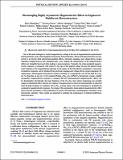Por favor, use este identificador para citar o enlazar a este item:
http://hdl.handle.net/10261/203616COMPARTIR / EXPORTAR:
 SHARE
BASE SHARE
BASE
|
|
| Visualizar otros formatos: MARC | Dublin Core | RDF | ORE | MODS | METS | DIDL | DATACITE | |

| Título: | Disentangling Highly Asymmetric Magnetoelectric Effects in Engineered Multiferroic Heterostructures |
Autor: | Menéndez, Enric CSIC ORCID; Sireus, Veronica; Quintana, Alberto; Fina, Ignasi CSIC ORCID CVN ; Casals, Blai CSIC ORCID CVN; Cichelero, Rafael CSIC; Kataja, Mikko; Stengel, Massimiliano CSIC ORCID; Herranz, Gervasi CSIC ORCID; Catalán, Gustau CSIC ORCID; Baró, María Dolors; Suriñach, Santiago; Sort, Jordi CSIC ORCID | Fecha de publicación: | 23-jul-2019 | Resumen: | One of the main strategies to control magnetism by voltage is the use of magnetostrictive-piezoelectric hybrid materials, such as ferromagnetic-ferroelectric heterostructures. When such heterostructures are subjected to an electric field, piezostrain-mediated effects, electronic charging, and voltage-driven oxygen migration (magnetoionics) may simultaneously occur, making the interpretation of the magnetoelectric effects not straightforward and often leading to misconceptions. Typically, the strain-mediated magnetoelectric response is symmetric with respect to the sign of the applied voltage because the induced strain (and variations in the magnetization) depends on the square of the ferroelectric polarization. Conversely, asymmetric responses can be obtained from electronic charging and voltage-driven oxygen migration. By engineering a ferromagnetic-ferroelectric hybrid consisting of a magnetically soft 50-nm thick Fe 75 Al 25 (at. %) thin film on top of a 〈110〉-oriented Pb ( Mg 1 / 3 Nb 2 / 3 ) O 3 - 32 Pb Ti O 3 ferroelectric crystal, a highly asymmetric magnetoelectric response is obtained and the aforementioned magnetoelectric effects can be disentangled. Specifically, the large thickness of the Fe 75 Al 25 layer allows dismissing any possible charge accumulation effect, whereas no evidence of magnetoionics is observed experimentally, as expected from the high resistance to oxidation of Fe 75 Al 25 , leaving strain as the only mechanism to modulate the asymmetric magnetoelectric response. The origin of this asymmetric strain-induced magnetoelectric effect arises from the asymmetry of the polarization reversal in the particular crystallographic orientation of the ferroelectric substrate. These results are important to optimize the performance of artificial multiferroic heterostructures. | Versión del editor: | http://dx.doi.org/10.1103/PhysRevApplied.12.014041 | URI: | http://hdl.handle.net/10261/203616 |
| Aparece en las colecciones: | (ICMAB) Artículos |
Ficheros en este ítem:
| Fichero | Descripción | Tamaño | Formato | |
|---|---|---|---|---|
| Menendez_PhysRevAppl_2019_editorial.pdf | 4,22 MB | Adobe PDF |  Visualizar/Abrir |
CORE Recommender
Page view(s)
136
checked on 16-abr-2024
Download(s)
144
checked on 16-abr-2024
Google ScholarTM
Check
NOTA: Los ítems de Digital.CSIC están protegidos por copyright, con todos los derechos reservados, a menos que se indique lo contrario.
